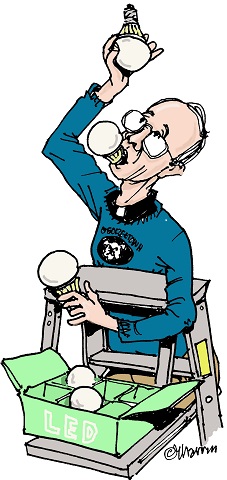
Illustration by Pat Marrin
At the end of January, I wrote a column describing my efforts to concretely implement Laudato Si’, the pope’s environmental encyclical, by insulating the heating and water pipes in the Jesuit residence where I live in Washington, D.C.
My next project at Neale House, named after Leonard Neale, S.J., the second archbishop of Baltimore, was to upgrade to more efficient light bulbs. A number of readers had suggested this, indicating that many Americans recognize this as a good way to save money and reduce your carbon footprint.
It is amazing how many light bulbs our residence has. The three-story-plus-basement building is over 100 years old, and was purchased in the 1960s as a house for Jesuit graduate students because it was near Dupont Circle, halfway between Georgetown University and Catholic University of America. It is now the house for Jesuits working in national ministries.
It has a large living room, dining room, chapel, parlor, kitchen, 17 bedrooms, eight bathrooms, three restrooms, two TV rooms, two pantries, laundry, and two storage rooms. It may sound like "Downton Abbey," but I assure you it is not. More like an old mansion converted into a second-rate boarding house.
In any case, the third floor alone, where I live, has about 70 light bulbs. I lost count after that.
And what variety we have when it comes to light bulbs! We have the usual 40-, 60-, and 100-watt bulbs for lamps, but also candelabra bulbs of various wattages with both small and large bases. Then there are spotlights, both large and small.
I was not the first resident to look at our lighting system. Before I arrived two years ago, someone had already converted many of our incandescent lights to spiral fluorescent bulbs. This was the best technology available at the time, but it has some drawbacks. Florescent bulbs are slow in lighting up, they cannot be used with a dimmer, they can overheat and burn out in enclosed fixtures, and they contain mercury, which makes them difficult to dispose of safely.
The newer LED light bulbs are much better. They are dimmable and come in many shapes and sizes and are more energy efficient. Incandescent bulbs waste a lot of energy producing heat in addition to their light.
My first challenge was the dining room, which has four wall sconces and one large light fixture in the center of the ceiling. The sconces already had florescent bulbs, so I left them alone. The fixture in the center of the ceiling, which used four large bulbs, had not been upgraded to fluorescent bulbs because it was on a dimmer. The dimmer provides bright light in the morning for reading the newspaper but softer light in the evening for dinner.
I knew that one of the keys to keeping people happy is to make sure that the new bulbs are at least as bright if not brighter than the old ones. If they are dimmer, people will grumble. One of the old bulbs in the dining room fixture was 150 watts. I am amazed we did not blow out our dimmer.
One of the secrets of upgrading is to wash the light fixture when you replace the old lights. Light fixtures are magnets for dust and grime. Simply washing the fixture increases the light by 10 percent or more. If you wash the fixture when replacing the lights, people will think you have put in brighter bulbs. Don’t tell them otherwise.
Washing and drying the light fixture is, of course, the most dangerous part of the job. It is easy to get tired and sloppy from going up and down ladders, unscrewing and re-screwing fixtures. That is when you make mistakes and break the glass fixture. I am proud to tell you I successfully washed all the fixtures in the house without breaking one. More on the outside fixtures later.
I made my first mistake with the dining room light. I knew this light had to be really bright so people could read the newspaper while having breakfast. I installed four 100-watt replacement "daylight" LED bulbs. I picked "daylight" because it has more lumens than "soft white." Lumens is the measure of the brightness of a light bulb.
Big mistake. They hated it. The light was too harsh.
The good news is that when I switched over to four 100-watt replacement "soft white" LED bulbs with a clean fixture, people thought I had put back the old bulbs. I was able to use the "daylight" bulbs in pantries and storage rooms where it did not matter.
Each of these 100-watt replacement LED bulbs uses only 18 watts but gives as much light as a 100-watt incandescent bulb. I also replaced the incandescent bulbs in a similar large ceiling fixture in the chapel without anyone noticing the difference. With these successes, I earned the credibility I needed to work on the rest of the house.
Next the bathrooms. Some already had florescent bulbs, but others did not. Each bathroom had two lights, one on each side of the mirror over the sink. Some had 100-watt bulbs, others 60. I replaced them all with 60-watt replacement "soft white" LED bulbs. Again, washing the fixtures made a big difference. These LED bulbs use only 10 watts.
The hallway lights were a special challenge. For one thing, each floor had different styles.
My floor, formerly the servants’ quarters on the third floor, has two wall sconces without switches that are on 24/7. They already had small candelabra style florescent bulbs, which provide 40-watt equivalent light but use only 7 watts. I could have replaced them with 4.5-watt LED bulbs but it hardly seemed worth the cost.
The second floor, the family quarters, was more challenging. Here the hall lights were five lantern-style fixtures hanging from the ceiling by chains. Each had two 40-watt candelabra-style incandescent bulbs because they are on dimmers, and frankly the fluorescent candelabra bulbs look terrible.
I cleaned the glass and placed one 40-watt replacement LED bulb in each fixture. The LED candelabra bulbs look much better than fluorescents and provide enough light so no one has noticed that I only put one bulb in each fixture. Each bulb consumes only 4.5 watts.
Also on the second floor was the bulletin board, without which you cannot have a Jesuit residence. This was lit by six small 50-watt incandescent flood lights.
Here I made my second mistake. I went online and found 40-watt replacement LED bulbs that were exactly the same size. The problem was I did not notice that these bulbs had two different types of bases (the part that connects to the fixture). I needed GU10 and I ordered GU5.3. The GU5.3 simply plugs into the socket while the GU10 is plugged in and then twisted slightly to lock it into the socket.
Luckily Home Depot has a generous return policy since the bulbs were $5.95 each and I had ordered 10 to replace those at the bulletin board and over the ironing board in the laundry room. Yes, some Jesuits iron their shirts. I am a perma-press man myself.
Meanwhile, I went from room to room inspecting the lights. I left most of the fluorescents that I found and replaced the remaining incandescents with LED bulbs. But I did run into a couple of difficulties.
First, three-way (50w/100w/150w) bulbs are a special problem. There are no three-way LED bulbs, at least that I found. The florescent three-way bulbs are not that reliable. Three-way incandescent bulbs are not all that great either, with the brightest level always burning out first. And often the three-way switches on the lamps break, making good connections difficult. I bought a few three-way florescent bulbs, but where no one would notice, I simply put in a 100-watt replacement LED.
[Update. A reader brought to my attention a three-way LED bulb for $21.97, which he says works well.]
Second, many of our bedrooms had ceiling fans with lights attached. Most of those with pull chains used regular bulbs that could be replaced with 40-watt equivalent LED or florescent bulbs, but those on dimmers tended to have weird sized bulbs.
My own, for example, had candelabra style bulbs inside the fixture, but when I attempted to replace them with LED bulbs, the lights would not turn off. Actually, if I replaced one bulb I could turn off the fixture but not if I replaced both. Strange. Perhaps it is a wiring problem. In any case, it is above my level of expertise.
Finally, I attacked the outside lights and made two more mistakes. The first had a happy ending; the second did not.
The first mistake was made replacing a burnt out bulb on a light under our porch. I thought the glass front was on a hinge, so when I unhitched it, gravity took over and it shattered on the cement. [Expletive deleted].
This was exactly the problem I was assiduously avoiding inside the house. This meant I had to replace the entire fixture or somehow get a replacement part. Using my iPhone, I took a picture of the label describing the manufacturer and model number. I retreated to my computer, Googled the company but could find no way to order a part. I did find a customer service email address, so I described my problem and they sent me a replacement part (actually two) for free. So, here is a shout out for Heath Zenith.
My last mistake did not have a happy ending.
We have a large lantern-style light hanging by a conduit over the front porch. When warmer weather arrived, I gently washed the glass (I could not remove it) and replaced the incandescent bulb with a light detector and a 100-watt replacement LED bulb. I had some trouble getting the light detector to screw in and then it looked like it might be so low in the fixture that it would never turn off.
All of this took place at the top of a 9-foot-tall stepladder. After I finished, I left the ladder on the front porch in case I had to tinker with the light later; it was gone the next morning. [Expletives deleted.] Well at least the light detector and bulb are working well.
So ends my adventure upgrading the lights at our house. All told, I replaced about 80 light bulbs. The new bulbs were not cheap, ranging as low as $3.32 for a 60-watt equivalent soft white general purpose LED Bright Stik light bulb to $19.97 for the outside 100-watt equivalent bulb for the front porch. Most were in the $4.50 to $7 range. All of these lights will save money and last for years. To the extent they use less energy, they also reduce our carbon footprint.
As to "How many Jesuits does it take to change a light bulb?" That is a Jesuitical secret for you to guess and "ours" to know. Feel free to present your guesses in the comment section below.
[Jesuit Fr. Thomas Reese is a senior analyst for NCR and author of Inside the Vatican: The Politics and Organization of the Catholic Church. His email address is treesesj@ncronline.org.]
Editor's note: We can send you an email alert every time Thomas Reese's column, Faith and Justice, is posted. Go to this page and follow directions: Email alert sign-up.
